SimplyFun produces some beautiful games and puzzles for all ages, many of which will appeal to home educators. They sell through consultants and home parties but they also sell through their website. On the website they offer a “PlaySaver Annual Membership”—for a $19 annual membership fee you receive 15% off all games and puzzles plus two free "social" games - Take Your Pick and Let's Chat. This might be a good “investment” if you consolidate some school and gift shopping and order a number of items. Getting to the PlaySaver Club page is challenging. Click here to get into the shopping area, then search for "playsaver club" to bring up the information you need. You might also consider hosting a home party to share products with friends and family and earn free and half-price items!
I have reviewed selected examples just to give you a sense of the variety of games they offer. One interesting feature of SimplyFun games is that all are designed to be played within 30 minutes or less. That makes them very practical for homeschool situations where you want to use a game as part of your class time. It also makes game playing more practical within the busy schedules of most families.
Games I’ve seen and reviewed all were constructed much better than typical games. Boards are thick and sturdy. The artwork is beautiful. Boxes for the games even have a textured finish and are printed on the bottom of the box, and these boxes won’t fall apart quickly as do so many other game boxes.
Below is just a sampling. I've written separate reviews for a few of my outstanding favorites, Clover Leap, Fourmation, Math Medalist, Let's Jet, Let's Drive, and SavannaScapes. Among other SimplyFun products are an alphabet puzzle, preschool ABC’s, 123’s and sequencing puzzles (vital skills for math and reading), card games, family and group-play games, dexterity games, and strategy games like Dish 'em Out that don’t take days to play! There’s even a Sudoku Challenge board game that is reversible offering Zoodoku for the youngest players and a traditional Sudoku game on the reverse side--a great way to introduce young children to the game.
Letter Slide

Letter Slide is a great game for practicing spelling skills for children ages seven and up. Each player has a game board with a curving slide with letters to be covered with letter tiles. To earn letter tiles, players turn over cards from the card deck and try to spell four-letter words by filling in the missing letters. They draw from the "Letter Lagoon's" 200 letter tiles. Cards have either the first two or last two letters of words (e.g., "C O _ _" or "_ _ T E"). As an extra touch, typical of the SimplyFun games, vowels on both cards and tiles are red while consonants are black.
The game comes with a one-minute timer. Regular game play is timed, and players will try to come up with as many words as they can for a single card within one minute. If that's too much pressure, another option omits the timer and asks children to create only one word per turn. For younger players you might separate cards, beginning with only the cards that provide the beginning letters of words. With younger players, you might consider suggesting words and have them try to spell the words themselves rather than requiring them to think up and spell words. While two to four people can play at a time, I think it's probably best with no more than three players to avoid excessive frustration over the unavailability of desired letter tiles. Two hundred tiles sounds like (and looks like) a lot of tiles, but I found that even with two players we were competing for the last of the four "w's" toward the end of the game. On the other hand, older children might find the strategy of having to compete for tiles one more element of challenge that makes the game fun.
Front Runner
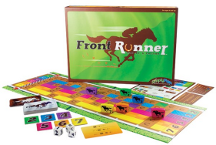 Front Runner is a challenging math game that works on factoring skills. While the instructions recommend the game for ages eight and up, the SimplyFun website says it's for teens and families. I would suggest it for children about sixth grade level and above who have mastered addition, multiplication, and subtraction, and who understand the order of operations.
Front Runner is a challenging math game that works on factoring skills. While the instructions recommend the game for ages eight and up, the SimplyFun website says it's for teens and families. I would suggest it for children about sixth grade level and above who have mastered addition, multiplication, and subtraction, and who understand the order of operations.Players have one or more horses that will run on the game board track. All six horses (numbered two through seven) will run each race, so they are divided up according to the number of players. For each turn, players draw an equation card with three different equations. Usually the first equation is simplest and the last equation the most complex. Players select which equation they will solve, then roll the three dice that come with the game. Two dice have numbers one through six and one has numbers zero through nine. Players then plug the numbers into the equation in a specified order and solve the equation. But they're not done yet. Next they determine whether the numbers of their horses (possibly any combination of numbers two through seven) are factors of the answer to their equation. If so, their horses with a number equal to a factor each advance along the track to the next horseshoe space. Horseshoe spaces are more frequent for the number two and least frequent for the number seven, reflecting the frequency with which those numbers as factors are likely to occur. So horse number seven has to move six horseshoe spaces while horse three must move eleven horseshoe spaces to win. There are cards that add a few more complications to the game, but I think you get the basic idea. Players will need paper and pencil to work out answers to some of the equations as well as their factors.
Younger players can choose the simpler equations and still win, but more sophisticated players will realize that choosing a lengthier equation might increase the odds of coming up with a larger number with more factors. Much still depends upon the numbers rolled with the dice.
This is a fantastic way for students to practice math facts, order of operations, and factoring, but Front Runner does give players a real mathematical workout.
Sumology
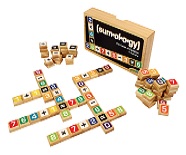
Sumology is the game that caught my eye at a conference. This is like playing Scrabble with math. Once children have learned the four basic operations, they can play by building equations that connect to other equations. They use numbers 0 through 9, operation signs, and equal signs, but they can create equations with large numbers as well. This is a great way to elicit lots of math fact practice in a format that is much more appealing than worksheets. The strategy involved also makes this fun for anyone older to join in. Rules can be modified so that your first grader uses only addition and subtraction symbols while more advanced players add the multiplication and division. Each person can play at their own level!
Bank It!

So many “bank” games are too old for children in the elementary grades, requiring them to compute percentages or perform other math functions they haven’t yet learned. Bank It! is perfect for third and fourth graders, and children up through about eighth grade should enjoy playing too. The game functions a little like Monopoly in that players move around the edge of the board with spaces, with various events happening in each space. Players are racing to accumulate enough money to purchase a bike, but before they can do so they must earn money, spend money in four “stores,” donate to charity with time or money, and deposit money in the bank. Money is in the form of plastic coins equal in size and shape to our US coinage. While coins do not resemble actual coins, denominations match, so children learn to count and make change with the money.
The ingenious game board has a folding “shopping mall” that inserts into the center. The board sits inside the box, and children track their bank deposits by sliding a money clip along a “graph” on their edge of the outside of the box lid. Unlike Monopoly, children can finish playing this game in a reasonable amount of time!
Chess on the Loose
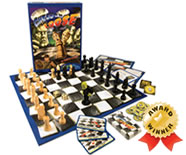
Chess is a great strategy game, super for teaching advanced planning, multi-step thinking, consideration of cause and effect, patience, and other valuable life skills. Chess on the Loose is a great way to introduce the game of chess. Playing pieces and instructions are included for the basic game and three variations. The variations really make the game even more interesting… or maybe frustrating. “Frankencheck” introduces a Frankencheck monster piece onto the board. Frankencheck takes a turn in the normal round of play, but he moves according to instructions on Frankencheck cards while other players play by the regular rules. There’s no telling what he might do, so it adds an element of unpredictability to the game.
In the “Treasure Chessed” variation, treasure chest tiles are placed in the middle of the board. Players follow normal play except when they land on a treasure tile. They can risk staying in place to “dig” on their next turn with the possibility of winning points for a successful dig. If so, they risk making themselves vulnerable by staying in one spot too long. Players win by gaining the most points from the treasure.
“U.F.O. Spell Check” puts “battery tokens with letters such as “bi, gh, k, ni,” or “o” on the board between the normal chess pieces. As players land on spaces with battery tokens, they collect them and attempt to spell “rook, knight,” or “bishop.” Two each of these three playing pieces are provided as “extras” that players can win as they are able to spell the name of the piece. Those new pieces are then entered into play.
The variations might make the game more appealing to newcomers ages eight and up, and even skilled players will enjoy the variations on this traditional game.
Expanders
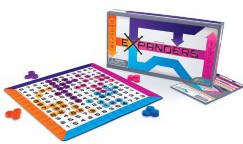
Expanders is good for practicing addition skills, especially "reverse addition"—figuring out which numbers will add up to the sum that the player wants. It's even better for critical thinking and spatial reasoning. Each time you play you construct a unique game board with a frame and up to six "circuit boards." Circuit boards have numbers in different arrangements. Numbers go up to "8" on one side and up to "12" on the reverse for greater difficulty. You'll get a different arrangement just about every time you set up the circuit boards, so players can't memorize a "best way to play."
Players use colored tokens to cover numbers, choosing from different options each time. "Expanding" from one number (your sum) to a group of adjacent numbers that add up to your sum is usually the best way to play, but other strategies are available when no sums are possible. As players develop skill, they begin to strategize the directions they want to go on the board, both for their own advantage and to block other players.
From one to four people can play at a time. The publisher suggests it for ages seven and up, but I think you would have to help most seven- and eight-year olds because there are so many options for them to consider each time. Adults should enjoy the game too!
The Reel Script
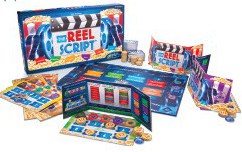
The Reel Script is suggested for ages eight and up, and it requires from three to five players. Ideally, players should be at similar educational levels, but I think you might try partnering younger children with adults or older siblings to even things up.
As you can see from the illustration, the game has quite a few pieces. The general idea is that players try to collect cards with story elements that they can weave into a short story script. Cards are divided into six categories: adventure, detective, history, drama, action, and family. The cards have story elements such as "Shakespeare, the White House," "Spartacus," "Rapunzel," "the far side of the moon," "receives a gift from a secret admirer," "realizes all is not quite as it seems," "is defeated by," "after breakfast," "deep in the woods," and "escapes with his/her life." Players are allowed to include two connecting words before or after each card, and they can change verb tenses, but otherwise, they have to create the story with only the words on the cards. With 270 cards, script storylines are unlikely to repeat. The luck of the draw as well as playing strategies help players acquire a set of cards that might be silly or sensible. Players win by constructing the best script, and gain extra points by using particular cards.
The game helps students think about elements required to make a coherent story. It takes a little time to sort out how to set it up and play, and players have to continually think about which cards might help advance their storyline. So the game takes some concentration, but it should encourage creativity.
Homeschoolers might take it a step further by having students actually write out a short story script from the cards they have accumulated, but only do that if students enjoy it.







